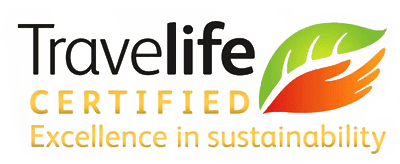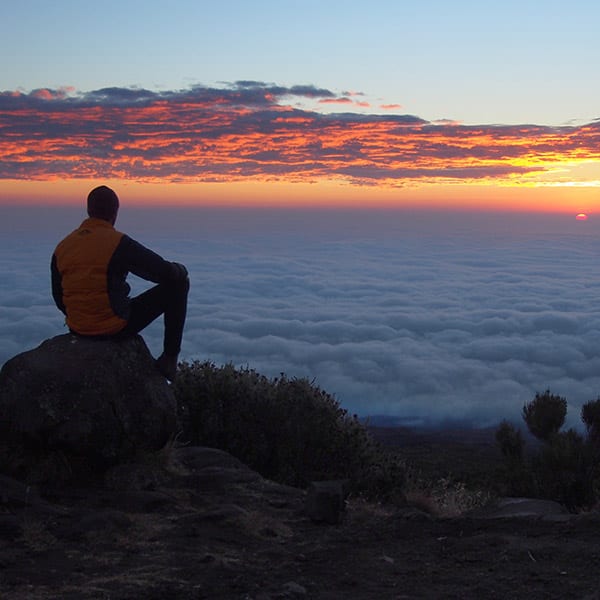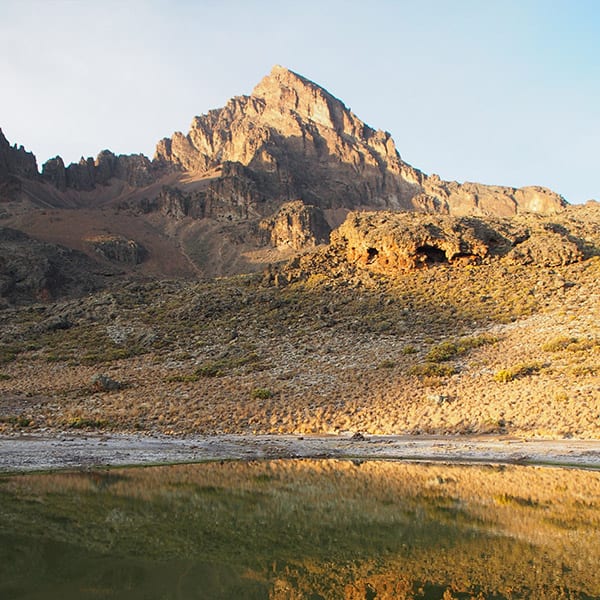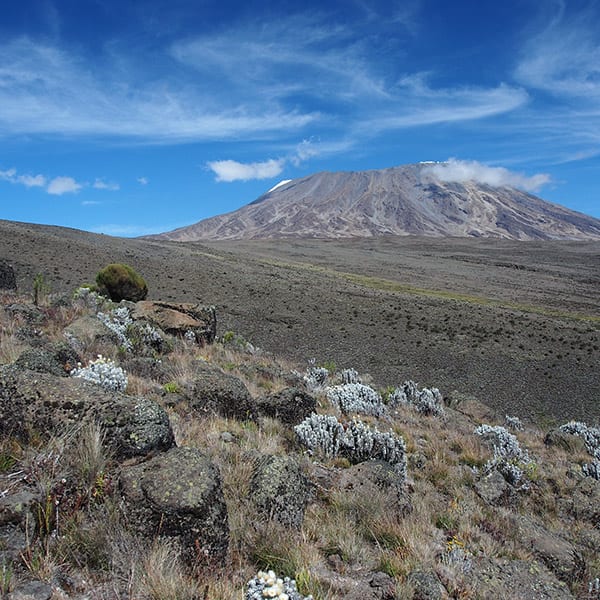Mt Kilimanjaro
Tanzania
Witness the sun rise over the East African plains as you stand at the summit of the world’s highest freestanding mountain.
Trip duration:
9 days
Challenge duration:
7 days
Challenge grade:
5/5
Departure months:
February, June, September - November
Accommodation:
Twin-share in 3-star hotels and comfortable camping
Hiking Mt Kilimanjaro
Rising impressively from the rainforests of the East African plains, the snow-capped peak of Kilimanjaro is an awe-inspiring sight. To stand at its summit is to quite literally stand on top of the world.
On this 9-day adventure, you will be pushed both physically and mentally as you trek through five different climatic zones under the care of experienced local guides.
Trekking from farmlands to verdant rainforest, through alpine meadow and across the barren lunar-like landscape to the summit, this adventure is sure to change your life.

Why you'll love this adventure
- Feel the elation of standing on top of the world’s highest freestanding mountain, the mighty Kilimanjaro (5,895m) and gazing out over the stunning East African plains.
- Climb through rainforests, ice fields and alpine meadows and camp in the shadow of glaciers.
- Build lifelong friendships and camaraderie with like-minded teammates, all united by your passion for your chosen cause and the desire to travel for good.

We partner with a local travel operator for this adventure who is Travelife Certified. You can find out more here.
Trip notes
Day 1: Arrive in Kilimanjaro
Upon arrival in Kilimanjaro, you will be met and transferred to Moshi, where you will meet the rest of your team and be met by your guide for the trip. The guide will deliver a full briefing as well as carry out equipment checks and help with hiring additional equipment if needed. Moshi is located in the foothills of Mount Kilimanjaro and is known as a coffee-producing hub as they boast vast coffee plantations.
Accommodation: Lodge
Meals: D
Day 2: Moshi - Rongai Gate - Simba
This morning we will have a 2-3 hour transfer to the Rongai Nale Moru Gate near the Kenyan border. After arrival, we will begin our climb to Uhuru Peak, the roof of Africa, hiking through forests where we will see wildlife such as White and Black Colobus Monkeys, and the exotic Hartlaub's Turaco, a large bird with a violet blue tail, red wing tips, a blue-black head, and eyes surrounded by white. This peak has an elevation gain of 800m or 2,500ft. We will have lunch together on the trail before continuing on to our first campsite of the trek where we will rest for the night.
Accommodation: Camping
Transfer time: 2-3 hours
Trekking distance: 6km
Meals: B L D
Day 3: Simba - Kikelewa
Today’s trekking will take us through Kilimanjaro’s moorland, where the morning of hiking is steep and you will begin to feel the altitude. You will notice the growing altitude today in your legs and the rhythm of your breathing. Your guide will advise you to go “pole, pole” (“slowly, slowly”) if they think your pace is too fast for the altitude.The total elevation gain for today will be 1000m or 3,400ft. We will stop to rest at a cave and take some time to explore, before resuming our hike and having lunch at Second Cave, a natural cave formed by the cooling of lava. The afternoon of hiking is easier as we cross the moorland and approach our campsite for the night, which is in a sheltered valley at Kikelewa.
Accommodation: Camping
Trekking distance: 15km
Meals: B L D
Day 4: Kikelewa - Mawenzi Tarn
Today will mainly be an acclimatisation day, where we will hike in the morning then rest in the afternoon and evening. The hike in the morning is rather short, but it is steep, though we will be rewarded with superb all-round views and a tangible sense of wilderness. The elevation gain of today will be 730m or 2,400ft. We then make our way to our campsite at Mawenzi Tarn, which is situated below Mawenzi Peak and offers stunning views of Mawenzi and Kibo.
Accommodation: Camping
Trekking distance: 7km
Meals: B L D
Day 5: Mawenzi Tarn
This morning we will have a small sleep in and do another acclimatisation walk. We can pick between 2 walks depending on how we are feeling - a steep walk toward the peak of Mawenzi, or a gentle climb to the ridge of the lunar desert and visit the eerie site of a plane crash. After embarking on one of these walks, we will return to Mawenzi Tarn for a hot lunch and restful afternoon.
Accommodation: Camping
Trekking distance: 2km
Meals: B L D
Day 6: Mawenzi Tarn - Kibo Huts
We depart our camp for the last 2 nights and make our way across the lunar landscape of the saddle between Kibi, the summit cone and Mawnezi. The crossing is exposed and can be very windy, though it is spectacular. The elevation gain for today is 370m or 1,200 ft. Today we are hiking towards Kibo Huts Camp, our home for the night, which is situated directly below the summit, offering amazing views over the Kenyan plains and Mawenzi. After lunch and a full summit briefing, we will spend time resting to prepare for our summit tomorrow.
Accommodation: Camping
Trekking distance: 11km
Meals: B L D
Day 7: Summit Mount Kilimanjaro
Today is the big summit day, where we will begin the final ascent to Uhuru Peak, which is the highest point in Africa. We will begin hiking at around midnight and use the light of our head torches to navigate our way for the next 6 hours. The most challenging part of the entire trek is the ascent to the crater rim. The trail consists mostly of steep switchbacks known as Jamaica Rocks, which we will scramble over as we approach the crater rim at Gilman’s point, which sits at 5,756m. The hike from Gilman’s to Uhuru Peak is a gradual climb and not too difficult, though the altitude makes the hike long and tiring. The sun rises and the plains of Africa are stretched out below us - we did it! After summit celebrations, we will descend to Kibo Huts, where we will eat and replenish our energy before continuing our descent to Horombo Huts, our campsite for the night. The elevation gain is 1,195m or 3,940ft and elevation loss is 2,175m or 7,140ft.
Accommodation: Camping
Trekking distance: 16.5km
Meals: B L D
Day 8: Horombo Huts - Marangu Gate - Moshi
After a well deserved sleep, we have breakfast and finish off the trek with a descent to Marangu Gate today. This last hike on Kilimanjaro is a beautiful one as we pass through Kilimanjaro’s cloud forest. The elevation loss for today is 1,890m or 6.200ft. Once we reach the end, we will be transferred back to Moshi.
Accommodation: Lodge accommodation
Trekking distance: 19km
Meals: B L D
Day 9: Depart Kilimanjaro
This morning you will get to relax until the team transfer to Kilimanjaro international Airport for your flight home.
Meals: B
Day 1: Arrive in Kilimanjaro
Upon arrival in Kilimanjaro, you will be met and transferred to Moshi, where you will meet the rest of your team and be met by your guide for the trip. The guide will deliver a full briefing as well as carry out equipment checks and help with hiring additional equipment if needed. Moshi is located in the foothills of Mount Kilimanjaro and is known as a coffee-producing hub as they boast vast coffee plantations.
Accommodation: Lodge
Meals: D
Day 2: Moshi - Rongai Gate - Simba
This morning we will have a 2-3 hour transfer to the Rongai Nale Moru Gate near the Kenyan border. After arrival, we will begin our climb to Uhuru Peak, the roof of Africa, hiking through forests where we will see wildlife such as White and Black Colobus Monkeys, and the exotic Hartlaub's Turaco, a large bird with a violet blue tail, red wing tips, a blue-black head, and eyes surrounded by white. This peak has an elevation gain of 800m or 2,500ft. We will have lunch together on the trail before continuing on to our first campsite of the trek where we will rest for the night.
Accommodation: Camping
Transfer time: 2-3 hours
Trekking distance: 6km
Meals: B L D
Day 3: Simba - Kikelewa
Today’s trekking will take us through Kilimanjaro’s moorland, where the morning of hiking is steep and you will begin to feel the altitude. You will notice the growing altitude today in your legs and the rhythm of your breathing. Your guide will advise you to go “pole, pole” (“slowly, slowly”) if they think your pace is too fast for the altitude.The total elevation gain for today will be 1000m or 3,400ft. We will stop to rest at a cave and take some time to explore, before resuming our hike and having lunch at Second Cave, a natural cave formed by the cooling of lava. The afternoon of hiking is easier as we cross the moorland and approach our campsite for the night, which is in a sheltered valley at Kikelewa.
Accommodation: Camping
Trekking distance: 15km
Meals: B L D
Day 4: Kikelewa - Mawenzi Tarn
Today will mainly be an acclimatisation day, where we will hike in the morning then rest in the afternoon and evening. The hike in the morning is rather short, but it is steep, though we will be rewarded with superb all-round views and a tangible sense of wilderness. The elevation gain of today will be 730m or 2,400ft. We then make our way to our campsite at Mawenzi Tarn, which is situated below Mawenzi Peak and offers stunning views of Mawenzi and Kibo.
Accommodation: Camping
Trekking distance: 7km
Meals: B L D
Day 5: Mawenzi Tarn
This morning we will have a small sleep in and do another acclimatisation walk. We can pick between 2 walks depending on how we are feeling - a steep walk toward the peak of Mawenzi, or a gentle climb to the ridge of the lunar desert and visit the eerie site of a plane crash. After embarking on one of these walks, we will return to Mawenzi Tarn for a hot lunch and restful afternoon.
Accommodation: Camping
Trekking distance: 2km
Meals: B L D
Day 6: Mawenzi Tarn - Kibo Huts
We depart our camp for the last 2 nights and make our way across the lunar landscape of the saddle between Kibi, the summit cone and Mawnezi. The crossing is exposed and can be very windy, though it is spectacular. The elevation gain for today is 370m or 1,200 ft. Today we are hiking towards Kibo Huts Camp, our home for the night, which is situated directly below the summit, offering amazing views over the Kenyan plains and Mawenzi. After lunch and a full summit briefing, we will spend time resting to prepare for our summit tomorrow.
Accommodation: Camping
Trekking distance: 11km
Meals: B L D
Day 7: Summit Mount Kilimanjaro
Today is the big summit day, where we will begin the final ascent to Uhuru Peak, which is the highest point in Africa. We will begin hiking at around midnight and use the light of our head torches to navigate our way for the next 6 hours. The most challenging part of the entire trek is the ascent to the crater rim. The trail consists mostly of steep switchbacks known as Jamaica Rocks, which we will scramble over as we approach the crater rim at Gilman’s point, which sits at 5,756m. The hike from Gilman’s to Uhuru Peak is a gradual climb and not too difficult, though the altitude makes the hike long and tiring. The sun rises and the plains of Africa are stretched out below us - we did it! After summit celebrations, we will descend to Kibo Huts, where we will eat and replenish our energy before continuing our descent to Horombo Huts, our campsite for the night. The elevation gain is 1,195m or 3,940ft and elevation loss is 2,175m or 7,140ft.
Accommodation: Camping
Trekking distance: 16.5km
Meals: B L D
Day 8: Horombo Huts - Marangu Gate - Moshi
After a well deserved sleep, we have breakfast and finish off the trek with a descent to Marangu Gate today. This last hike on Kilimanjaro is a beautiful one as we pass through Kilimanjaro’s cloud forest. The elevation loss for today is 1,890m or 6.200ft. Once we reach the end, we will be transferred back to Moshi.
Accommodation: Lodge accommodation
Trekking distance: 19km
Meals: B L D
Day 9: Depart Kilimanjaro
This morning you will get to relax until the team transfer to Kilimanjaro international Airport for your flight home.
Meals: B
Frequently asked questions
Can't find the answer to your question? Get in touch via email (info@inspiredadventure.com.au
About the adventure
How challenging is this adventure?
The Kilimanjaro trek is ranked 5/5. While no extensive trekking experience is required prior to registering, our adventures are specifically designed for people who are reasonably fit and willing to train. The Kilimanjaro trek is a physical challenge with long, consecutive days of trekking at high altitude. The fitter you are, the more you will enjoy the experience. Reaching the summit of Mount Kilimanjaro does not require mountain climbing skills. The actual climb is more like a very long walk up stairs, however, we cannot stress enough the importance of having the right trekking equipment and proper training.
Who will I be travelling with?
Our average group size at Inspired Adventures ranges from 10 to 20 people. You can be sure that you have all come together with the shared purpose of making a difference to others and having the adventure of a lifetime.
The group will be led by a local tour guide with expert knowledge of the region. Many groups will also be accompanied by an Inspired Adventures team leader or doctor to support and motivate the team.
Where applicable, a charity representative may also join the team. This is a wonderful opportunity to learn more about your chosen charity and their work.
Can I join an Inspired Adventure on my own?
Of course, most people do! Throughout your adventure journey, we will connect you with your fellow adventurers so you can get to know each other before you hit the road.
Fitness and training
How do I train for this adventure?
It is essential that you prepare for this challenge. We will provide you with basic information on things to consider when you register.
We recommend that you consult your GP and a personal trainer to develop a training plan that will prepare you for the challenge. The best physical preparation for a Kilimanjaro climb is any activity that simulates, as far as possible, the demands on your body during your ascent and descent.
You should aim to make walking up and down hills the main part of your training. Take regular and increasingly long walks to develop your muscles. You should be able to walk with a small pack for up to 8 hours a day for a number of consecutive days, and you will be walking for up to 15 hours on summit day.
In addition to your physical training, it’s important to be mentally prepared for the challenge. You might encounter setbacks and difficult periods during the trek, but remind yourself that many people have achieved this feat before you, and you can do it too. Maintain a positive attitude, and remember your guide will be there to encourage and inspire you all the way!
Will I make it to the summit?
Climbing Mt Kilimanjaro is a tough physical and mental challenge, but assuming you have prepared well and with the support of the guides and your team, it is likely you will reach the summit. Remember it doesn’t matter if you don’t and sometimes it is out of your control despite doing all the right things to prepare. It’s the journey that counts, after all.
Will I get altitude sickness?
The summit of Mt Kilimanjaro sits at 5,895 metres above sea level. Altitude sickness can affect anyone at heights over 2,500 metres, regardless of fitness. Symptoms of altitude sickness include headaches, loss of appetite, periods of sleeplessness and occasional shortness of breath. Most people will experience mild to moderate symptoms on some or all days during the ascent but generally find the symptoms tolerable and find quick relief on descent.
Nothing can truly prepare you for the altitude of 5,895 metres, but you can make your trek easier with proper training and by reaching a good fitness level. The better prepared you are, the more likely you will enjoy the experience and your body will be able to deal with the rigours of adapting to high altitudes. Staying hydrated and healthy on the climb is also paramount. It is a good idea to advise your GP you are trekking at altitude.
Accommodation
What is the accommodation like?
While in Moshi, you will be staying in a basic but comfortable 3-star hotel which has all the usual facilities you would expect.
You will be camping in twin share tents for the seven nights on the mountain. All your gear, except that which you’ll carry in your day pack, will be carried for you by the porters, who will run on ahead of you so when you arrive in the late afternoon, the campsite will be set up for you already.
We recommend that you bring a four season sleeping bag as well as a sleeping bag liner to keep warm during the night. Be sure to pack a sleeping mat that matches your desired level of comfort but keep in mind that although they are light they do take up a lot of space and there are restrictions on the amount of gear you can have on the mountain to look after the health and safety of the porters. Alternatively, you can choose to hire gear from our local partner in Tanzania.
Will I be sharing accommodation?
Accommodation on this adventure is based on twin-share. You will be paired with a teammate of the same gender and, whenever possible, age group. Single rooms and tents are available at an additional cost and subject to availability.
I’m travelling with a friend, can we stay together?
Of course! If you’re travelling with a friend, please make note of this and we will pair you together.
What to expect
What are the toilets like?
While you are camping you will not have access to showers, electricity or ordinary toilets. Campsites will either have portable chemical toilets or permanent facilities with long drops. Trekking breaks will be behind bushes and boulders. You take your toilet paper out with you in a zip top bag or similar and practice ‘leave no trace’ – keep Kili clean! You will carry your own supply of toilet paper, zip top bags and hand sanitiser in your day pack.
Are showers available?
While you are camping, you will not have access to showers. Warm bowls of washing water will be provided morning and night while on the mountain. Wet wipes are also useful for freshening up.
What is the food like?
Food on the mountain is generally hot and cooked daily. Breakfasts consist of porridge, eggs, toast and tea or coffee to start the day. Lunch can be packed or hot, dependent on where you are on the mountain and the length of the walk that day. You will always be provided with a hot, filling meal for dinner —usually soup followed by rice, potato or pasta and sauce, and sometimes fruit for dessert. You’ll be well-fed, but we recommend bringing a few of your favourite snacks whether that’s energy bars, nuts or dried fruit to help get you through the longer days and if the altitude is affecting your appetite. Any dietary requirements you’ve noted during booking will be catered for.
I have dietary requirements, will I be catered for?
Absolutely, we will happily arrange for any dietary requirements you’ve noted during booking to be catered for. Please advise your local guide and Team Leader on Day 1 as well. You’re free to bring snacks such as protein balls, lollies, gluten free or vegan treats with you. You will be fed very well while you’re on the adventure, but if you have a very specific dietary requirement or severe allergies, often it’s best to pack some extra things as back-up.
Is there mobile phone reception?
You will not have mobile coverage while on the mountain. Hotels may have wifi but it can be unreliable. A satellite phone will be carried by the team leader for emergencies.
Will I have access to electricity?
You will not have access to electricity while on the mountain.
Tanzania uses 230V/50Hz and outlet type D or G. We recommend that you bring a universal adapter. Some travellers find a portable power pack useful to charge their phone while out during the day.
What do I need to pack?
You will be sent a comprehensive packing list after you register for the adventure with everything you need to consider.
What happens if there is a medical emergency?
Providing the safest possible environment is our highest priority and we have an outstanding safety record. All Inspired Adventures guides and Team Leaders are first aid trained. Our guides carry satellite phones to be used if further assistance is required.
How will you manage the risk of COVID-19?
See the COVID-19 section of our website for full details.
Costs and payments
What’s included in the travel cost?
Package inclusions vary from trip to trip so please refer to the specific trip notes for details.
Generally, the travel cost includes:
- Transfers in private vehicles
- 2x group airport transfers each way
- Twin-share accommodation in 3-star hotels and comfortable camping
- All meals as per itinerary
- Drinking water
- Inspired Adventures Team Leader and/or Doctor
- All guides and trekking crew including cooks and porters
- All camping gear including mess tents, tents and chemical toilets, oxygen chamber
- National Park entrance and camping fees
What’s not included in the travel cost?
Package exclusions vary from trip to trip so please refer to the specific trip notes.
Generally, the travel cost does not include:
- Airfares
- Travel insurance (compulsory)
- Vaccinations
- Visa, if applicable
- Personal camping equipment (eg backpack, sleeping bag)
- Personal expenses
- Tips and gratuities
Are the travel costs subject to change?
We will do our best to keep the travel costs as quoted. However, please bear in mind they can change due to group size, currency fluctuations or factors out of our control. If absolutely necessary, Inspired Travel may have to add on an additional supplement fee should the current social distancing measures continue. This fee would be required if our operator needs to add on additional vehicles, equipment and/or staff.
Why do I need to pay a registration fee?
Upon registration, you will be required to pay a registration fee to secure your spot on the team. From the minute you register until you return from your adventure, the team at Inspired Adventures will provide you with everything you need - from a bespoke fundraising plan, fitness advice and travel preparations. You will receive access to your online adventure portal complete with your own online fundraising page and lots of resources to help you along the way. Your registration fee goes towards our cost of managing the adventure and supporting you on your journey.
How much spending money do I need?
We recommend that you allow USD$20 per day (approx. AUD$29) to cover any meals not included in the trip costs, souvenirs, gifts, drinks and any additional activities you may wish to participate in. It is possible to travel well on a smaller budget and you can always withdraw more money while away.
Is it customary to tip?
Tipping your trekking guides and crew is customary in Tanzania. The recommended tipping amount for this adventure is approximately $200 USD (approx. AUD$290) which will be spread across the whole trekking crew. You should tip only an amount you feel comfortable with, however. Hotels may also have a ‘tip box’ where you can place tips to be spread across staff. Otherwise, $1 USD notes can be given directly to staff for good service.
Travel insurance and visas
Do I need to have insurance?
Travel insurance is compulsory for international adventures to cover cancellation, hospital, emergency evacuation and lost luggage. We recommend purchasing your policy as soon as possible. It is up to you to ensure you have fully comprehensive travel insurance and you will need to share these details with our team before departure. For more information, please visit www.inspiredadventures.com.au/travel-insurance-information.
Do I need a visa to travel to Tanzania?
It is a requirement that Australian and New Zealand passport holders have a valid visa to enter Tanzania. For the most current requirements, refer to the Smartraveller website.
About Tanzania
Can I drink the water in Tanzania?
Even in Tanzanian cities, it is not safe to drink the tap water; it can cause severe illness. Purified drinking water in bottles is available everywhere, and is generally quite cheap. Check that the seal on the cap is not broken. On trekking days, you will be provided with purified water in the morning at the start of your trek. You will need enough water bottles or hydration systems to be able to carry up to 4 litres of water. A combination of bottles and a hydration system (ie. Camelbak) is best.
What is the weather like in Tanzania?
Tanzania has a tropical climate. In the highlands, temperatures range between 10°C and 20°C during cold and hot seasons respectively. The rest of the country has temperatures rarely falling lower than 20°C.
On the mountain, temperatures will vary greatly and will drop dramatically as you climb in elevation. Days tend to be warm and bright, although as soon as the sun sets, temperatures will frequently drop below 0°C. Layers are key and it’s important to bring rain gear as the weather can change quickly on the mountain.
Generally speaking, early mornings will warm up as soon as the sun rises and the days will be warm and bright. You will be trekking in very clear air and will need strong UV protection. Nights are usually clear and frosty so please remember this when considering your clothes for summit night and choosing your sleeping bag.
Is Tanzania safe?
While in Tanzania, we advise that you remain aware of your surroundings at all times. Never leave your belongings unattended, always keep an eye or a firm grip on cameras and shoulder bags, and avoid travelling alone, especially at night. Caution should be adopted in larger cities. When staying in hotels, secure all valuables and documents in a safe.
These are the same safety precautions we recommend when travelling to any destination.
Consult the Smartraveller website for the most up to date information.
Do I require any vaccinations for Tanzania?
Visit your GP to learn about any required vaccinations and to receive medical clearance to participate.
About the adventure
How challenging is this adventure?
The Kilimanjaro trek is ranked 5/5. While no extensive trekking experience is required prior to registering, our adventures are specifically designed for people who are reasonably fit and willing to train. The Kilimanjaro trek is a physical challenge with long, consecutive days of trekking at high altitude. The fitter you are, the more you will enjoy the experience. Reaching the summit of Mount Kilimanjaro does not require mountain climbing skills. The actual climb is more like a very long walk up stairs, however, we cannot stress enough the importance of having the right trekking equipment and proper training.
Who will I be travelling with?
Our average group size at Inspired Adventures ranges from 10 to 20 people. You can be sure that you have all come together with the shared purpose of making a difference to others and having the adventure of a lifetime.
The group will be led by a local tour guide with expert knowledge of the region. Many groups will also be accompanied by an Inspired Adventures team leader or doctor to support and motivate the team.
Where applicable, a charity representative may also join the team. This is a wonderful opportunity to learn more about your chosen charity and their work.
Can I join an Inspired Adventure on my own?
Of course, most people do! Throughout your adventure journey, we will connect you with your fellow adventurers so you can get to know each other before you hit the road.
Fitness and training
How do I train for this adventure?
It is essential that you prepare for this challenge. We will provide you with basic information on things to consider when you register.
We recommend that you consult your GP and a personal trainer to develop a training plan that will prepare you for the challenge. The best physical preparation for a Kilimanjaro climb is any activity that simulates, as far as possible, the demands on your body during your ascent and descent.
You should aim to make walking up and down hills the main part of your training. Take regular and increasingly long walks to develop your muscles. You should be able to walk with a small pack for up to 8 hours a day for a number of consecutive days, and you will be walking for up to 15 hours on summit day.
In addition to your physical training, it’s important to be mentally prepared for the challenge. You might encounter setbacks and difficult periods during the trek, but remind yourself that many people have achieved this feat before you, and you can do it too. Maintain a positive attitude, and remember your guide will be there to encourage and inspire you all the way!
Will I make it to the summit?
Climbing Mt Kilimanjaro is a tough physical and mental challenge, but assuming you have prepared well and with the support of the guides and your team, it is likely you will reach the summit. Remember it doesn’t matter if you don’t and sometimes it is out of your control despite doing all the right things to prepare. It’s the journey that counts, after all.
Will I get altitude sickness?
The summit of Mt Kilimanjaro sits at 5,895 metres above sea level. Altitude sickness can affect anyone at heights over 2,500 metres, regardless of fitness. Symptoms of altitude sickness include headaches, loss of appetite, periods of sleeplessness and occasional shortness of breath. Most people will experience mild to moderate symptoms on some or all days during the ascent but generally find the symptoms tolerable and find quick relief on descent.
Nothing can truly prepare you for the altitude of 5,895 metres, but you can make your trek easier with proper training and by reaching a good fitness level. The better prepared you are, the more likely you will enjoy the experience and your body will be able to deal with the rigours of adapting to high altitudes. Staying hydrated and healthy on the climb is also paramount. It is a good idea to advise your GP you are trekking at altitude.
Accommodation
What is the accommodation like?
While in Moshi, you will be staying in a basic but comfortable 3-star hotel which has all the usual facilities you would expect.
You will be camping in twin share tents for the seven nights on the mountain. All your gear, except that which you’ll carry in your day pack, will be carried for you by the porters, who will run on ahead of you so when you arrive in the late afternoon, the campsite will be set up for you already.
We recommend that you bring a four season sleeping bag as well as a sleeping bag liner to keep warm during the night. Be sure to pack a sleeping mat that matches your desired level of comfort but keep in mind that although they are light they do take up a lot of space and there are restrictions on the amount of gear you can have on the mountain to look after the health and safety of the porters. Alternatively, you can choose to hire gear from our local partner in Tanzania.
Will I be sharing accommodation?
Accommodation on this adventure is based on twin-share. You will be paired with a teammate of the same gender and, whenever possible, age group. Single rooms and tents are available at an additional cost and subject to availability.
I’m travelling with a friend, can we stay together?
Of course! If you’re travelling with a friend, please make note of this and we will pair you together.
What to expect
What are the toilets like?
While you are camping you will not have access to showers, electricity or ordinary toilets. Campsites will either have portable chemical toilets or permanent facilities with long drops. Trekking breaks will be behind bushes and boulders. You take your toilet paper out with you in a zip top bag or similar and practice ‘leave no trace’ – keep Kili clean! You will carry your own supply of toilet paper, zip top bags and hand sanitiser in your day pack.
Are showers available?
While you are camping, you will not have access to showers. Warm bowls of washing water will be provided morning and night while on the mountain. Wet wipes are also useful for freshening up.
What is the food like?
Food on the mountain is generally hot and cooked daily. Breakfasts consist of porridge, eggs, toast and tea or coffee to start the day. Lunch can be packed or hot, dependent on where you are on the mountain and the length of the walk that day. You will always be provided with a hot, filling meal for dinner —usually soup followed by rice, potato or pasta and sauce, and sometimes fruit for dessert. You’ll be well-fed, but we recommend bringing a few of your favourite snacks whether that’s energy bars, nuts or dried fruit to help get you through the longer days and if the altitude is affecting your appetite. Any dietary requirements you’ve noted during booking will be catered for.
I have dietary requirements, will I be catered for?
Absolutely, we will happily arrange for any dietary requirements you’ve noted during booking to be catered for. Please advise your local guide and Team Leader on Day 1 as well. You’re free to bring snacks such as protein balls, lollies, gluten free or vegan treats with you. You will be fed very well while you’re on the adventure, but if you have a very specific dietary requirement or severe allergies, often it’s best to pack some extra things as back-up.
Is there mobile phone reception?
You will not have mobile coverage while on the mountain. Hotels may have wifi but it can be unreliable. A satellite phone will be carried by the team leader for emergencies.
Will I have access to electricity?
You will not have access to electricity while on the mountain.
Tanzania uses 230V/50Hz and outlet type D or G. We recommend that you bring a universal adapter. Some travellers find a portable power pack useful to charge their phone while out during the day.
What do I need to pack?
You will be sent a comprehensive packing list after you register for the adventure with everything you need to consider.
What happens if there is a medical emergency?
Providing the safest possible environment is our highest priority and we have an outstanding safety record. All Inspired Adventures guides and Team Leaders are first aid trained. Our guides carry satellite phones to be used if further assistance is required.
How will you manage the risk of COVID-19?
See the COVID-19 section of our website for full details.
Costs and payments
What’s included in the travel cost?
Package inclusions vary from trip to trip so please refer to the specific trip notes for details.
Generally, the travel cost includes:
- Transfers in private vehicles
- 2x group airport transfers each way
- Twin-share accommodation in 3-star hotels and comfortable camping
- All meals as per itinerary
- Drinking water
- Inspired Adventures Team Leader and/or Doctor
- All guides and trekking crew including cooks and porters
- All camping gear including mess tents, tents and chemical toilets, oxygen chamber
- National Park entrance and camping fees
What’s not included in the travel cost?
Package exclusions vary from trip to trip so please refer to the specific trip notes.
Generally, the travel cost does not include:
- Airfares
- Travel insurance (compulsory)
- Vaccinations
- Visa, if applicable
- Personal camping equipment (eg backpack, sleeping bag)
- Personal expenses
- Tips and gratuities
Are the travel costs subject to change?
We will do our best to keep the travel costs as quoted. However, please bear in mind they can change due to group size, currency fluctuations or factors out of our control. If absolutely necessary, Inspired Travel may have to add on an additional supplement fee should the current social distancing measures continue. This fee would be required if our operator needs to add on additional vehicles, equipment and/or staff.
Why do I need to pay a registration fee?
Upon registration, you will be required to pay a registration fee to secure your spot on the team. From the minute you register until you return from your adventure, the team at Inspired Adventures will provide you with everything you need - from a bespoke fundraising plan, fitness advice and travel preparations. You will receive access to your online adventure portal complete with your own online fundraising page and lots of resources to help you along the way. Your registration fee goes towards our cost of managing the adventure and supporting you on your journey.
How much spending money do I need?
We recommend that you allow USD$20 per day (approx. AUD$29) to cover any meals not included in the trip costs, souvenirs, gifts, drinks and any additional activities you may wish to participate in. It is possible to travel well on a smaller budget and you can always withdraw more money while away.
Is it customary to tip?
Tipping your trekking guides and crew is customary in Tanzania. The recommended tipping amount for this adventure is approximately $200 USD (approx. AUD$290) which will be spread across the whole trekking crew. You should tip only an amount you feel comfortable with, however. Hotels may also have a ‘tip box’ where you can place tips to be spread across staff. Otherwise, $1 USD notes can be given directly to staff for good service.
Travel insurance and visas
Do I need to have insurance?
Travel insurance is compulsory for international adventures to cover cancellation, hospital, emergency evacuation and lost luggage. We recommend purchasing your policy as soon as possible. It is up to you to ensure you have fully comprehensive travel insurance and you will need to share these details with our team before departure. For more information, please visit www.inspiredadventures.com.au/travel-insurance-information.
Do I need a visa to travel to Tanzania?
It is a requirement that Australian and New Zealand passport holders have a valid visa to enter Tanzania. For the most current requirements, refer to the Smartraveller website.
About Tanzania
Can I drink the water in Tanzania?
Even in Tanzanian cities, it is not safe to drink the tap water; it can cause severe illness. Purified drinking water in bottles is available everywhere, and is generally quite cheap. Check that the seal on the cap is not broken. On trekking days, you will be provided with purified water in the morning at the start of your trek. You will need enough water bottles or hydration systems to be able to carry up to 4 litres of water. A combination of bottles and a hydration system (ie. Camelbak) is best.
What is the weather like in Tanzania?
Tanzania has a tropical climate. In the highlands, temperatures range between 10°C and 20°C during cold and hot seasons respectively. The rest of the country has temperatures rarely falling lower than 20°C.
On the mountain, temperatures will vary greatly and will drop dramatically as you climb in elevation. Days tend to be warm and bright, although as soon as the sun sets, temperatures will frequently drop below 0°C. Layers are key and it’s important to bring rain gear as the weather can change quickly on the mountain.
Generally speaking, early mornings will warm up as soon as the sun rises and the days will be warm and bright. You will be trekking in very clear air and will need strong UV protection. Nights are usually clear and frosty so please remember this when considering your clothes for summit night and choosing your sleeping bag.
Is Tanzania safe?
While in Tanzania, we advise that you remain aware of your surroundings at all times. Never leave your belongings unattended, always keep an eye or a firm grip on cameras and shoulder bags, and avoid travelling alone, especially at night. Caution should be adopted in larger cities. When staying in hotels, secure all valuables and documents in a safe.
These are the same safety precautions we recommend when travelling to any destination.
Consult the Smartraveller website for the most up to date information.
Do I require any vaccinations for Tanzania?
Visit your GP to learn about any required vaccinations and to receive medical clearance to participate.
All information is subject to change and will be confirmed upon your registration.
Reviews
Past adventurers rated their overall experience trekking Mount Kilimanjaro as 4.62 out of 5
★★★★★
“Everything was great and well organised. Being prepared for summit night was a must. I wouldn’t have made it without all the prior information and preparation from Inspired.”
Helena
★★★★★
“I will never forget the massive high I experienced as we passed Gillman’s Peak towards the summit of Mt Kilimanjaro!”
Damian
★★★★★
“The highlight was definitely the local people, and the group making it to the top.”
Alyssa
★ ★ ★ ★ ★
“The hardest yet most rewarding thing I have ever done.”
Donna
Responsible Travel
Caring for our adventurers, the communities we visit and the wellbeing of the planet is the heart of everything we do. This adventure is no exception.
Meaningful connections: Hear from Aranda Elders who will tell us about the history of the area.
Environment: We offset the emissions from this trip through carbon credit programs in partnership with Carbon Neutral.
Treading lightly: Trekking is a great, low-impact way to explore.
Small group travel: Our teams consist of a maximum of 25 people. Better for you, and better for the planet.
Responsible business: We’re a certified B-Corp, committed to using business as a force for good
Upcoming adventures
Breast Cancer Network Australia – Kilimanjaro 2026
School of St Jude – Kilimanjaro trek
Forever Projects – Kilimanjaro Trek
CanToo – Kilimanjaro Trek
Do you want to take your supporters on an adventure-of-a-lifetime?
Enquire today about an itinerary for your organisation.
Thank you!








